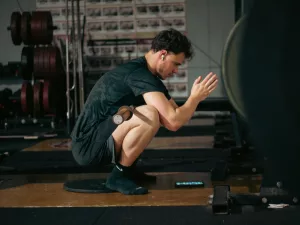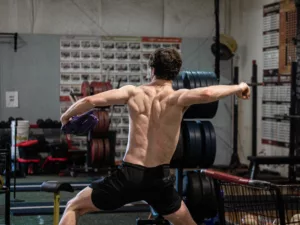 Baseball, the classic American sport, frequently catches players, managers, and spectators off guard with an unanticipated ailment known as the "yips." It appears that gamers have encountered an invisible barrier, changing things that were once second nature and easy into difficult and elusive problems. The question then becomes, what are these yips, and why do they occur in baseball?
Baseball, the classic American sport, frequently catches players, managers, and spectators off guard with an unanticipated ailment known as the "yips." It appears that gamers have encountered an invisible barrier, changing things that were once second nature and easy into difficult and elusive problems. The question then becomes, what are these yips, and why do they occur in baseball?
TopVelocity believes that a large portion of the mystery might be ascribed to a lack of understanding of throwing biomechanics. It's an exciting area, delving into the intricate movements and mechanics that go into each pitch. The time has come to unravel this riddle and discover the underlying variables that contribute to the perplexing phenomena of baseball yips.
What Causes Yips in Baseball?
TopVelocity attributes it to a lack of understanding of pitching biomechanics
The term "yips" refers to an athlete's sudden, inexplicable loss of fine motor abilities. In baseball, these yips appear as a sudden inability to make efficient throws, particularly in pitchers. Yips can appear out of nowhere and make even the most experienced baseball players powerless.
TopVelocity has established that a major contributor to the yips is the players' understanding—or rather, misunderstanding—of pitching biomechanics. When the pitch release does not line up with the pitcher's body movement, the balance and control required for a successful delivery are compromised, resulting in inconsistent performance.
Pitching Biomechanics: The Building Blocks of Every Throw
 Every pitch comprises a complex combination of body components that all work in unison to deliver the baseball to its intended target. Pitching biomechanics refers to the coordination of these aspects (legs, hips, trunk, shoulders, arm, and hand).
Every pitch comprises a complex combination of body components that all work in unison to deliver the baseball to its intended target. Pitching biomechanics refers to the coordination of these aspects (legs, hips, trunk, shoulders, arm, and hand).
When a pitcher understands these biomechanics completely, their performance skyrockets. However, a misunderstanding of fundamental principles can result in incorrect movements, poor balance, and pitch disruption.
Changes in Anatomy: The Silent Saboteur
Anatomical changes, like a tightening hip, might cause a pitch's biomechanics to shift. These slight alterations can have a significant impact on the pitcher's action and delivery. Consider what happens if a car's wheel alignment shifts. The car can still travel, but only with obvious wobbles, straying off course, or incurring tire wear and tear.
The Impossibility of Repairing Without Understanding
Once the yips have set in, the pitcher frequently scrambles to correct the situation. However, if they don't understand the underlying biomechanical issue, they're more likely to treat the symptoms rather than the reason. It's like placing a band-aid on a deep wound: it may momentarily halt the flow, but the wound underlying remains unhealed.
Hip Tightening: A Cause of Yips in Baseball
 Any physical change in the body, like a tightened hip, might have serious consequences for a pitcher. The hip is an important part of the pitching motion, providing the stability and torque required for a forceful and accurate throw.
Any physical change in the body, like a tightened hip, might have serious consequences for a pitcher. The hip is an important part of the pitching motion, providing the stability and torque required for a forceful and accurate throw.
Pitching Biomechanics and the Hip
The hip is the key driver in the pitching action, commencing the kinetic chain that culminates in the throw. A tight hip can interrupt this kinetic chain, compromising biomechanics and, as a result, pitch velocity, accuracy, and consistency.
Understanding the Kinetic Chain: The Key to Pitching Success
Understanding pitching biomechanics requires an understanding of the kinetic chain. Consider it a chain of interconnected links that begins with the ground and ends with the ball's release. If one link, such as the hip, fails, it can disturb the entire chain, resulting in inconsistent performance and possibly harm.
Tackling Hip Tightness
Rest, physiotherapy, stretching, and strengthening exercises are used to treat a stiff hip. Incorporating hip mobility activities into training routines can help to prevent tightness from developing in the first place. But keep in mind that these procedures are only effective if they are properly understood and applied.
Chasing the Tail in the Vicious Cycle of Yips in Baseball
 Without a good grasp of what causes the yips, a pitcher may end up going in circles, or, as we like to say at TopVelocity, "chasing their tail." They're attempting to solve the problem, but without understanding the underlying reason, they're fighting a losing battle.
Without a good grasp of what causes the yips, a pitcher may end up going in circles, or, as we like to say at TopVelocity, "chasing their tail." They're attempting to solve the problem, but without understanding the underlying reason, they're fighting a losing battle.
The Importance of Pitcher Education
The first step toward addressing yips is to educate pitchers on the delicate biomechanics involved in their effectiveness. It enables students to better understand their bodies and their movements, allowing them to make more educated decisions regarding their training and approaches.
Getting Rid of the Yips: A Holistic Approach
Overcoming the yips necessitates a multifaceted approach that takes into account both the physical and psychological components. This includes biomechanical instruction, mental conditioning, and physical training in the pitcher's regimen.
Using the 3X Pitching Velocity Program to Overcome Yips in Baseball
 When yips appear unwelcomely on the mound, the remedy may appear elusive. But have no fear, since the 3X Pitching Velocity Program is a game changer. The 3X Pitching Velocity Program has proven time and again to be the best strategy for overcoming the yips by combining thorough understanding, creative training methodologies, and a focus on unique pitcher's demands.
When yips appear unwelcomely on the mound, the remedy may appear elusive. But have no fear, since the 3X Pitching Velocity Program is a game changer. The 3X Pitching Velocity Program has proven time and again to be the best strategy for overcoming the yips by combining thorough understanding, creative training methodologies, and a focus on unique pitcher's demands.
- Individualized Strategy: To begin, the 3X Pitching Velocity Program recognizes that each pitcher is unique, with distinctive strengths, limitations, and obstacles. As a result, the program takes a tailored approach to training, understanding that what works for one pitcher may not work for another. The program takes into account each athlete's unique biomechanics, previous injuries, and specific goals to develop a customized strategy that allows them to overcome their distinct yips-related issues.
- Comprehensive Biomechanics Knowledge: The 3X Pitching Velocity Program's secret weapon is its deep dive into pitching biomechanics. The curriculum delves into the science and biomechanics of pitching, equipping athletes with the knowledge they need to better understand their bodies and motions. This information enables athletes to make appropriate improvements to their technique, thus addressing the fundamental cause of the yips.
- Training that is both focused and progressive: Rather than a quick fix or a band-aid approach, the 3X Pitching Velocity Program focuses on gradually improving the pitcher's throwing mechanics and strength. This method instills good habits, reinforces muscle memory, and improves overall pitching effectiveness, assisting players in overcoming the yips. The program stresses high-velocity pitching mechanics, increased strength and agility, and mental toughness. Each of these components is essential in overcoming the yips.
- Aftercare and Ongoing Assistance: Overcoming yips is not a one-time event. It necessitates persistent effort, close monitoring, and appropriate modifications along the route. As a result, the 3X Pitching Velocity Program provides ongoing assistance even after the initial training session. This helps athletes not only overcome their yips but also sustain their better performance over time.
Finally, the 3X Pitching Velocity Program is more than just a training program. It is a full remedy to the yips, providing the necessary knowledge, training, and support to conquer this baseball problem. It's no surprise that with its focused approach and devotion to understanding pitching biomechanics, it's the best choice for pitchers wishing to strike out the yips and recapture their game.
FAQs: Yips in Baseball
- What exactly are yips in baseball?
The term "yips" refers to athletes' sudden, unexplainable loss of motor skills. In baseball, this frequently manifests as a pitcher's sudden inability to make efficient throws. - According to TopVelocity, what causes yips?
TopVelocity believes that a lack of understanding of pitching biomechanics is a primary contributor to yips. Anatomical alterations, such as a tightening hip, can also cause these biomechanics to shift, resulting in inconsistent pitching performance. - What effect does a tightened hip have on a pitcher's performance?
The hip is an important part of the pitching motion because it starts the kinetic chain that ends with the ball being released. A tight hip can interrupt this chain, affecting the pace, accuracy, and consistency of the pitch. - Why is it vital to understand pitching biomechanics?
Understanding pitching biomechanics provides pitchers with a good understanding of their bodily motions. This understanding can assist them in making informed judgments about their training and practices, as well as addressing problems at their root rather than merely the symptoms. - How can you get rid of yips?
Overcoming yips necessitates a multifaceted approach that tackles both physical and psychological factors. This includes pitching biomechanics instruction, mental fitness, physical training, and dealing with any anatomical alterations. - In this context, what does "chasing their tail" mean?
In the context of yips, "chasing their tail" refers to pitchers' useless attempts to resolve their performance concerns without first recognizing the underlying biomechanical abnormalities that are producing them.
The root of yips in baseball is still a mystery, trapping countless players in a maddening cycle of underperformance and bewilderment. TopVelocity associates yips with a lack of awareness of pitching biomechanics and the consequences of anatomical alterations, such as a tightening hip. Breaking away from the yips necessitates a thorough comprehension of these factors as well as a holistic approach to the game. Indeed, the remedy is not to chase one's tail, but to confront the problem with knowledge and devotion.
3X Velocity Camp can help you improve your game
 The road to overcoming yips is typically a difficult one, but with the correct training and awareness, it becomes much less scary. If you want to break free from the yips and attain your full potential as a pitcher, the 3X Velocity Camp is your next significant step.
The road to overcoming yips is typically a difficult one, but with the correct training and awareness, it becomes much less scary. If you want to break free from the yips and attain your full potential as a pitcher, the 3X Velocity Camp is your next significant step.
- It's Time to Act: The 3X Velocity Camp is a hands-on, intensive event that puts the 3X Pitching Velocity Program's principles into reality. It's a fantastic opportunity to go deep into the subject of pitching biomechanics, improve your pitching velocity, and strengthen your mental fortitude on the mound. Why struggle with the yips when there's a tried-and-true approach ready to help you on your way to greater performance?
- Training Experience That Is Unique: You will not receive generic coaching at the 3X Velocity Camp. Rather, you will receive specialized training that is tailored to your specific needs, biomechanics, and goals. You'll go through tests, training sessions, and mental conditioning to treat your specific issues, including the yips.
- Take Advantage of Professional Advice: The 3X Velocity Camp, led by professionals who understand the yips issue and have years of experience working with a variety of pitchers, is the ideal atmosphere to refine your skills, develop a deeper understanding of your pitching biomechanics, and permanently eliminate the yips from your game.
- Become a Part of a Successful Community: Participating in the 3X Velocity Camp is about more than just improving your pitching. It's about joining a group that understands your problems, your passion, and your desire to better. You'll meet other athletes who are equally devoted to conquering their yips, forming a support network that goes beyond the camp.
Finally, the moment to act is now. Allow the yips to keep you from reaching your best ability on the mound. Sign up for the 3X Velocity Camp today to get started on your path to becoming a better, yips-free pitcher. The ball is in your court; take a swing and connect for a strike.




